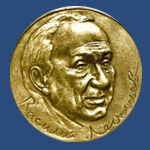
|
Robert M. Solow

Date of Birth: August 23, 1924
Position: Honored professor of Massachusetts Institute of Technology, Nobel Prize winner
Awarded for contribution to the development of the theory of economic growt
Robert Solow was born in Brooklyn, New York in a Jewish family on August 23, 1924, the oldest of three children.He was well educated in the neighborhood public schools of New York City and excelled academically early in life. In September 1940, Solow went to Harvard College with a scholarship. At Harvard, his first studies were in sociology and anthropology as well as elementary economics.
By the end of 1942, Solow left the university and joined the U.S. Army. He served briefly in North Africa and Sicily, and later served in Italy during World War II until he was discharged in August 1945.
He returned to Harvard in 1945, and studied under Wassily Leontief. As his research assistant he produced the first set of capital-coefficients for the input-output model. Then he became interested in statistics and probability models. From 1949-50, he spent a fellowship year at Columbia University to study statistics more intensively. During that year he was also working on his Ph.D. thesis, an exploratory attempt to model changes in the size distribution of wage income using interacting Markov processes for employment-unemployment and wage rates.
In 1949, just before going off to Columbia he was offered and accepted an Assistant Professorship in the Economics Department at Massachusetts Institute of Technology. At M.I.T. he taught courses in statistics and econometrics. Solow’s interest gradually changed to Macroeconomics. For almost 40 years, Solow and Paul Samuelson worked together on many landmark theories: von Neumann growth theory (1953), Theory of capital (1956), linear programming (1958) and the Phillips Curve (1960).
Solow also held several government positions, including senior economist for the Council of Economic Advisers (1961–62) and member of the President’s Commission on Income Maintenance (1968–70). His studies focused mainly in the fields of employment and growth policies, and the theory of capital.
In 1961 he won the American Economic Association’s John Bates Clark Award, given to the best economist under age forty. In 1979 he was president of that association.
In 1987, Robert Solow won the Nobel Prize for his analysis of economic growth. In 1999, he received National Medal of Science. He is a trustee of the Economists for Peace and Security.
Solow’s model of economic growth, often known as the Solow-Swan neo-classical growth model as the model was independently discovered by Trevor W. Swan and published in "The Economic Record" in 1956, allows the determinants of economic growth to be separated out into increases in inputs (labour and capital) and technical progress. Using his model, Solow calculated that about four-fifths of the growth in US output per worker was attributable to technical progress.
Solow also was the first to develop a growth model with different vintages of capital. The idea behind Solow’s vintage capital growth model is that new capital is more valuable than old (vintage) capital because capital is produced based on known technology and because technology is improving. Both Paul Romer and Robert Lucas, Jr. subsequently developed alternatives to Solow’s neo-classical growth model.
Since Solow’s initial work in the 1950s, many more sophisticated models of economic growth have been proposed, leading to varying conclusions about the causes of economic growth. In the 1980s efforts have focused on the role of technological progress in the economy, leading to the development of endogenous growth theory (or new growth theory). Today, economists use Solow’s sources-of-growth accounting to estimate the separate effects on economic growth of technological change, capital, and labor.
Solow currently is an emeritus Institute Professor in the MIT economics department, and previously taught at Columbia University.
Вернуться в галерею
|